For three hours we’ve been in this small tube with its quiet mechanical sounds. Out the window, glimpses of the Pacific Ocean at the edge of North America, surely lapping against it. The edge is green with dense forests and this green leads up toward rugged peaks, peaks barren but for snow that melts and flows down toward the ocean in creeks, streams and rivers, starting a new cycle. The features, largely indistinguishable. I know that there are landmarks, Misty Fiords National Monument, Ketchikan, Glacier Bay, Kahliak River, but I can’t make them out. The ground seems to be static, but is different when I look again. If only I could be down there with boots on the ground, I could get a sense of what I’m seeing. I can’t wait to escape these

confines and get in touch with that earth. We’re headed north to see kids and grandkids, north to Alaska, North to the Future(the official motto), The Last Frontier, the 50th state, Land of the Midnight Sun, the rush is on and I will chase after it, with notebook and camera in hand. I’ll share what I discover about the land I see and its history. I’ll drive 1,000 of the 4,900 miles of paved highways, along the Parks, Richardson, Glenn and Seward sections. I can’t see it all, but I will see its heart. The images will mostly be “roadkill” (semi-technical term for drive-quick stop-drive) and I’ll be grateful for them. I’m eager to share them with you. This is a long post, I’ll let you peek at the images here and then include the link at the bottom as well.
Please enjoy this place and these images. Come back and read the rest. You’ll like it.
Across the road I see another airfield that includes a lake with float planes spread around its perimeter, Merrill Field, an general use airport to support private aircraft, wheeled, ski- and float-equipped. These
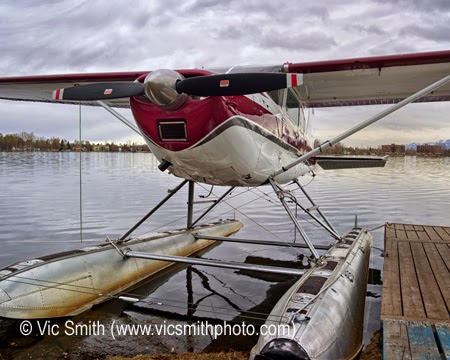
facilities paint a picture about Alaska. It is the largest state, 20% the size of the lower 48, combined, with more coastline than all 48, combined. It’s statewide population would fit into Seattle, WA, and 43% do fit into the largest cities, Anchorage and Fairbanks. 82% of its communities are not connected to the road system, relying entirely on air service, and only 2% of its land is accessible by roads (local saying: where the road ends, the real Alaska begins). No wonder it has eight times more airplane boardings per capita than any other state and needs airports. This is wild country, not Disneyland.
Clouds and rain shadow the road north, to Denali and its National Park. There are hills and trees and, on my left, the mighty Alaska Range, its peaks, and its glaciers. The trees are mostly spruce, black and white, pointed up like an ascending rocket. The road passes over and along rivers and creeks. Narrow lakes appear occasionally. Alaska has over 12,000 rivers, creeks and streams, 9,700 of which are officially named. It has more than 3 million lakes. It has 100,000 glaciers. It has 17 of the the 20 highest peaks in the US, five of which are on Denali, to our left. It’s a shock for someone from the southwest. The visual scale will soon start to match the geographical scale.
Denali NP covers almost 12,000 sq mi in south central Alaska. Within it is a 3,400 sq mi wilderness. 400,000 people (60% of the Alaskan population) visit the park annually. Many hike and backpack in the back country, but many more see it in a hosted bus along the narrow ribbon of dirt road from the Parks Highway deep into the country, six hours(each way) to the Kantishna camp and four hours(each way) to the Eielson Visitor Center.
The Denali Road reveals a land that both old and new. It is old from a biologic perspective. On my trip, I saw Dall Sheep, Grizzly Bears, Caribou, a campground fox and other smaller critters (of the park’s 223 species). The bus had to stop at one point and add bikers wisely stopped because of a grizzly near the road. Another trip reported seeing 72 Dall Sheet, 14 Moose, 30 Caribous, 2 foxes, 4 squirrels, and 1 Grizzly. These sightings are exciting.They can remind us of a much longer time frame. Humans arrived here about 15,000 years ago, across the Bering Land Bridge. The resident animals and plants are part of a much longer story. A swedish spruce, similar to the trees found in Denali, has been dated back nearly 10,000 years. Polar bears date back at least 100,000 years, evolving from the even-earlier grizzly bear. The moose, really a large deer, dates back at least 1 million years. There are records of dinosaurs, at least 65 million years old, when Denali was starting to rise. Simple life forms are even older. The future here starts from an old past.
The humans who arrived 15,000 years ago have much learned much about this land. There are still 20 native languages among their descendants, most belonging either to the Eskimo-Aleut or Athabascan-Eyak-Tlingit language families (go to the Alaska Native Medical Center in Anchorage to hear them and see the wonderful handwork produced). These people developed ways of life to successfully survive in the harsh climate of Alaska. They hunted, fished, and used available materials to build lives and communities. Along the way they told stories that named important landmarks, like Alaska, Alyeska (Aleut for “mainland” or “the object toward which the action of the sea is directed”) and Denali(Koyukon for “the high one”), the frozen wave where the second humans appeared. This is a working landscape full of meaning.
The land looks empty to us, people of the congested world, because of its scale and sparsity of apparent habitation, so it’s designation as a “frontier” seems understandable. Some of this is blatant boosterism, meant more to sell than to inform. But some of it is also a modern need to escape complications. Unlike our Puritan fore-bearers who saw wilderness as a place of chaos and threat, we tend to see it as place for personal space and “freedom”, real or imagined. Whether it be from a viewpoint, from a trail, or across a meadow, it becomes a place for expansion and release; we breathe deep and move out. The land, however, is shared by many living things and is not really empty.
This land is old but it is also new, from the perspective of earth history. Like much of the US West Coast, Alaska is an assembled land, by the movement of the earth’s crust, intersectons of the earth’s plates and migration of island fragments. The earth is about 4.6 billion years old and these events started in the last 4% of that history. By contrast, the Hudson Bay area of Canada hosts rocks deposited when 13% of the earth history had unfolded. Alaska is a late bloomer.
Plate intersections can result in one plate getting pushed below another, subduction, producing magma that forms the magma core of new mountains. Look at the Alaska Range, including Denali’s peaks, and the Polychrome Mountains, to see these results. Denali has been growing for about 60 million years and continues to rise today at about 1 mm per year. If one takes the bus to Eileson Visitor Center in Denali, the Polychrome Mountains will be traversed. These colorful edifices are the result of volcanic eruptions, with red, yellow and brown magma, rising from the plate action. At the Visitor’s Center, one can see, if cloud’s permit, the north side of “The High One”, rising 17,000 to 20,237 ft, a prominence of 20,073 ft, 3rd in the world. If you can’t see it (a frequent occurrence and one I shared), a local quilter has provided a beautiful image of it and the Park Service has put its outline on the facing window. Alaska is indeed a new land, but its a late bloomer on the earth stage .
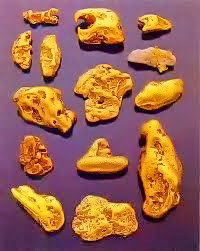
Driving north from Denali, one arrives at Fairbanks, founded when a riverboat trying to reach the gold rushes got stuck in the Tanana River. It has been key to Alaska’s quest for gold and to its more recent oil rush. Gold and oil are also the result of Alaska’s assembling. Island fragments originated elsewhere, mostly south, and then migrated, pushed by the forces of the earth’s plates until they collided with North America. These fragments have names like Yukon-Tanana and Wrangellia. Alaskan highways cross many of them. Imagine the Galápagos Islands, pushed north until they slam into a growing Alaska. The island impacts started about 200 millions years ago, in the last 4% of the earth’s history. With all of the diverse pieces assembled together, there have been lots of seams, places available to bring superheated water up from the earth’s restless mantle to the crust, water that carried precious materials with it, like the rounded nuggets of gold. The Circle City rush of 1893, Yukon Rush of 1896, the Nome rush of 1898, the Fairbanks rush of 1902 were all the recipients of this gift (there are 16 mining districts in interior Alaska). Alaska gold is still attractive today as cable TV reveals.
The assembling has also provided petroleum, in the North Slope. This was a piece of land that was once
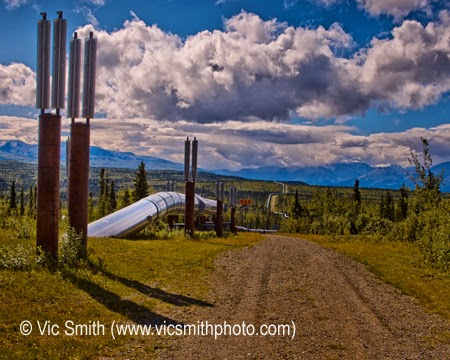
covered in plant life when North America was at a lower latitude. The fauna was then buried in the right way to result in hydrocarbons. And then North America was spun to the north and the North Slope was moved to its present position, an immigrant ready to provide treasure. The oil pipeline is a faithful companion as the highway runs south.
Now it’s south to the coast. Grand mountains still dominate, but instead of the tundra/taiga of the north, the coast is a wetter, temperate,place. Both Valdez and Seward get lots of snow (200+ inches per year). And both are important places in the sweep of history. Both, along with Skagway, were key embarkation points for gold-rushers headed north. Today they provide glimpses into the bounty of Alaska’s fishing waters and views of its coastal glaciers, key tourist attractions.
This story wouldn’t be complete without noting the interesting people, some successful and others not so much, who filled the stories I’ve heard about Alaska. Here are a few of them: Adolph Murie, an early
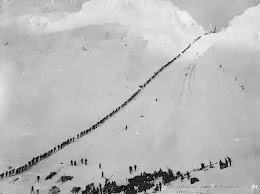
naturalist around Denali who taught us about wolves and their prey; the 100,000 Yukon gold-rushers risking all to find magical nuggets over Chilkoot Pass in the Yukon; Bradford
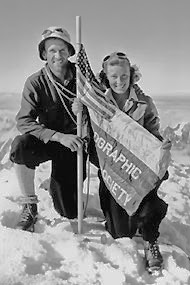
Washburn bagging peaks and leaving brilliant photographic images; Bob Reeve and other incredibly brave “bush pilots”, who have provided critical access to the backcountry; Fanny Quigley baking pies in frozen Kantishna, gathering five gallons of blueberries for each pie, killing a bear for its rendered fat, and then driving her sled to Healey with enough gold to buy flour and sugar, but also Chris McCandless overcome by the wild; Timothy Treadwell, lost to grizzlies in Katmai while once again recording them; Richard White, lost to a grizzly while backpacking along the Toklat River(where I had photographed the river and the Polychromes). The Last Frontier is a place that inspires and cautions, a land “of illusions and of hard facts”(Robert Wrigley). And then there are the ordinary folks like our children and grandchildren who go to work and school every day and make lives for themselves. Together all these folks have made and are making Alaska an interesting place.
My favorite point in the Grand Canyon is the aptly-named Point Sublime. Alaska has so many sublime points that I doubt it will run short anytime soon. It will remain a haven for get-awayers. It’s status as a “treasure state” is another matter. It has had a bounty of precious metals, petroleum, fisheries, forests, and tourists. But these treasures can be fleeting, built on rushes that turn into bubbles. At present oil production, 90% of its state budget, is declining, 40% of its 1988 high, its fisheries are stretched, its glaciers and lake ice are melting, and its gold extraction challenged because of its likely impact on the world-class Bristol Bay salmon waters. Can the sublime substitute for hard cash?
I came as a tourist, notebook and camera in hand. It has taken a while to write this post, mostly because I have felt haughty, trying to put a place this big, that I’ve seen so little of, into a small place like a post. Now I feel like I’ve started to understand the stories and the reality of this land. I have seen Alaska in the Midnight Sun and dipped my toes in a river, but only started to come into the country. I would like to spend more time walking, feeling the earth crunch under my boots, waiting, feeling the breezes, hearing the sounds, smelling the earth, hopping across streams, watching spring flows. Maybe someday I can do those things. Still, I’m grateful for the brief glimpses that have been gifted to me and hope that my words portray Alaska faithfully.
There is a book list at the end of this piece, with material that has aided my understand of Alaska. If you want to see the land in images from insiders, look at the Hirschmann and Heacox works. If you want to see it from a journalist who has truly been “into the country”, read McPhee. If you want to read about the magic of Denali, read the Sherwonit anthology. If you want to experience the mountains, read Roberts. If you want to read about the need for realistic preparation, read Krakauer. If you want to read about the bush pilots, read Heacox, Hirschmann. And, if you want to read about the early Denali and its treasures, read Murie.
Books:
Alaska Light(Heacox)
Alaska(Hirschmann)
Coming Into The Country(McPhee)
Denali: A Literary Anthology(Sherwonit)
The Last of His Kind(Roberts)
Into The Wild(Krakauer)
Bush Pilots of Alaska(Heacox, Hirschmann, Thomas, Hammond
A Naturalist In Alaska(Murie)
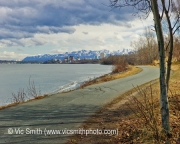
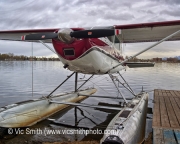
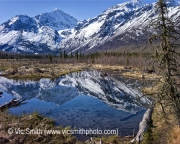
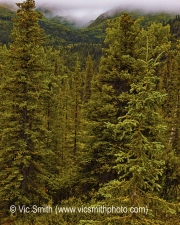
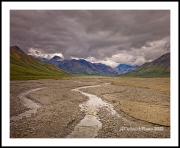
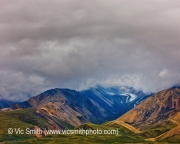
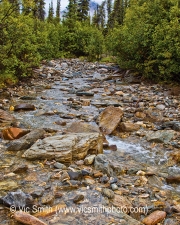
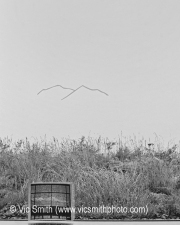
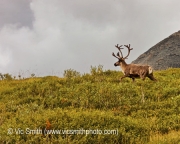
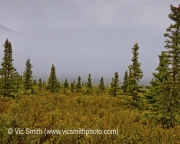
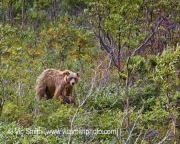
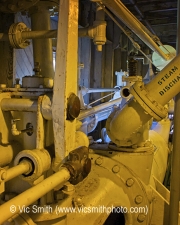
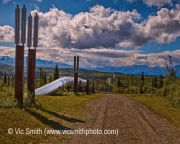
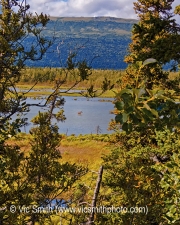
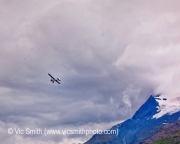
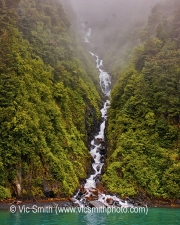
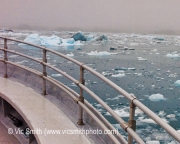
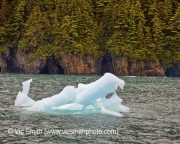
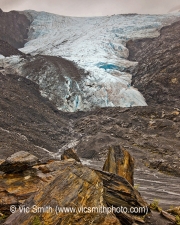
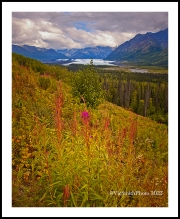
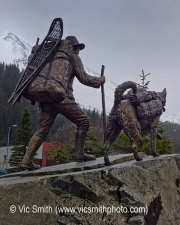
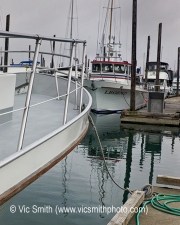
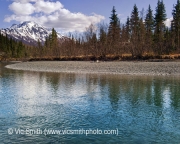
Great geologic descriptions in there! I love the plate stuff…. Thank you,